It looks like you're using an Ad Blocker.
Please white-list or disable AboveTopSecret.com in your ad-blocking tool.
Thank you.
Some features of ATS will be disabled while you continue to use an ad-blocker.
share:
reply to post by JustMike
Hi Mike! ;-)
Sorry for my delay back onto ATS.
It seems as I was waaay off. Still... nothing of major importance other than a few eyebrows raised.
I am glad I was off... however surprised.
Hi Mike! ;-)
Sorry for my delay back onto ATS.
It seems as I was waaay off. Still... nothing of major importance other than a few eyebrows raised.
I am glad I was off... however surprised.
reply to post by MamaJ
No problem, we all need to have our times away from here for various reasons.
Anyway, speaking of very quiet times on the world quake map, here's a screenshot from yesterday (Dec 17) at 12:49 UTC:
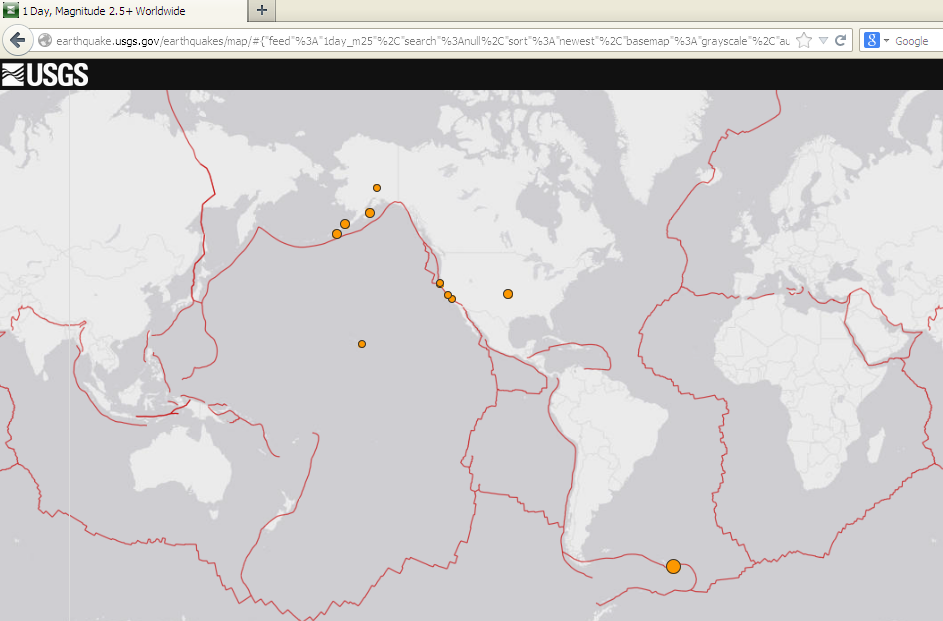
Now, that's a really quiet map!
Compare that to today (Dec 18) at 13:34 UTC, meaning a little under 25 hours later. (I couldn't get it bang on 24 hours. Had things to do!)
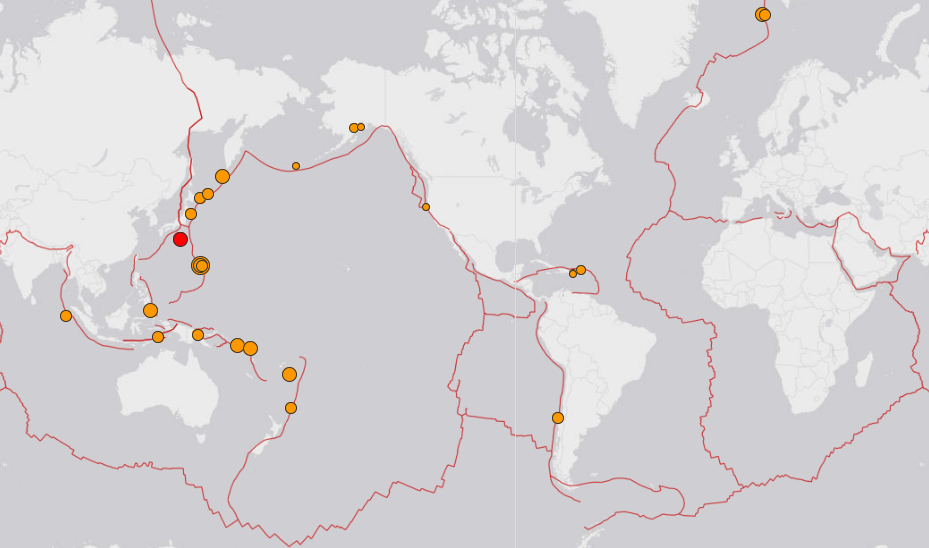
Much more "typical" of what we see every day.
And today, we finally got a mag 6-plus, the biggish orange one just SE of the red one:
The first mag 6-plus in 17 days, which is more than 5 times the average interval. So, we can note that one down, I guess.
Fortunately, today's mag 6.2 also demonstrated what I mentioned earlier, namely that a longer period of quiet does not have to be ended by anything really major or serious. This was a pretty shallow quake and though quite strong it was nothing extraordinary. I'm happy to say I have not found any reports of damage or injuries resulting from it.
I need to note that Geonet (NZ) reported a mag 6.2 in their own region on Dec 16, but USGS had it as a mag 5.6, which is quite a bit less, considering it's a logarithmic scale. Even if we allowed that one based on the Geonet report it was still a 15-day hiatus between mag 6 events.
There are often variations between the magnitudes reported by different agencies. This is rather annoying as it makes it look like there is plenty of margin for error and frankly it shouldn't happen that way. In the case of the above-mentioned mag 6.2 (NZ, Geonet) versus 5.6 (USGS), a mag 6.2 is about 4 times bigger on a seismo trace than a 5.6 and releases almost 8 times as much energy. Those are very significant differences!
Just for comparison, EMSC has today's quake as mag 6.3 (versus USGS 6.2) and the NZ quake from Dec 16 at mag 5.7 (USGS mag 5.6, Geonet NZ 6.2).
Here's where it gets puzzling. They all have access to the same basic data. So they should be much more consistent in assessing their final results. With quakes of this size, I see no major problem with a difference of (say) 0.1 to 0.2 magnitude (as between USGS and EMSC above), but when it's over 0.5 you have to wonder about the inconsistencies.
No problem, we all need to have our times away from here for various reasons.
Anyway, speaking of very quiet times on the world quake map, here's a screenshot from yesterday (Dec 17) at 12:49 UTC:

Now, that's a really quiet map!
Compare that to today (Dec 18) at 13:34 UTC, meaning a little under 25 hours later. (I couldn't get it bang on 24 hours. Had things to do!)

Much more "typical" of what we see every day.
And today, we finally got a mag 6-plus, the biggish orange one just SE of the red one:
(Data and both maps from USGS)
M6.2 - 195km E of Farallon de Pajaros, Northern Mariana Islands 2013-12-17 23:38:08 UTC
Event Time
2013-12-17 23:38:08 UTC
2013-12-18 09:38:08 UTC+10:00 at epicenter
2013-12-18 00:38:08 UTC+01:00 system time
Location
20.764°N 146.760°E depth=16.1km (10.0mi)
Nearby Cities
195km (121mi) E of Farallon de Pajaros, Northern Mariana Islands
623km (387mi) N of Saipan, Northern Mariana Islands
624km (388mi) N of Northern Islands Municipality - Mayor's Office, Northern Mariana Islands
652km (405mi) N of JP Tinian Town pre-WW2, Northern Mariana Islands
824km (512mi) NNE of Yigo Village, Guam
The first mag 6-plus in 17 days, which is more than 5 times the average interval. So, we can note that one down, I guess.
Fortunately, today's mag 6.2 also demonstrated what I mentioned earlier, namely that a longer period of quiet does not have to be ended by anything really major or serious. This was a pretty shallow quake and though quite strong it was nothing extraordinary. I'm happy to say I have not found any reports of damage or injuries resulting from it.
I need to note that Geonet (NZ) reported a mag 6.2 in their own region on Dec 16, but USGS had it as a mag 5.6, which is quite a bit less, considering it's a logarithmic scale. Even if we allowed that one based on the Geonet report it was still a 15-day hiatus between mag 6 events.
There are often variations between the magnitudes reported by different agencies. This is rather annoying as it makes it look like there is plenty of margin for error and frankly it shouldn't happen that way. In the case of the above-mentioned mag 6.2 (NZ, Geonet) versus 5.6 (USGS), a mag 6.2 is about 4 times bigger on a seismo trace than a 5.6 and releases almost 8 times as much energy. Those are very significant differences!
Just for comparison, EMSC has today's quake as mag 6.3 (versus USGS 6.2) and the NZ quake from Dec 16 at mag 5.7 (USGS mag 5.6, Geonet NZ 6.2).
Here's where it gets puzzling. They all have access to the same basic data. So they should be much more consistent in assessing their final results. With quakes of this size, I see no major problem with a difference of (say) 0.1 to 0.2 magnitude (as between USGS and EMSC above), but when it's over 0.5 you have to wonder about the inconsistencies.
edit on 18/12/13 by JustMike because: typos. Lots of typos!
reply to post by JustMike
Yes, that is a big difference and more typical.
I wish we knew how to calculate the next one, the one after that and so on. Of course, not much we could do in regards to safety unless it was a 24-48 hour in advance type of calculation.
Even if we could, imagine the mass panic!!
Yes, that is a big difference and more typical.
I wish we knew how to calculate the next one, the one after that and so on. Of course, not much we could do in regards to safety unless it was a 24-48 hour in advance type of calculation.
Even if we could, imagine the mass panic!!
reply to post by MamaJ
Yes, panic is a worry. I think the liability issue in the event of major predictions (at any "official" level) is something various authorities and groups of experts have long pondered over. This would apply especially in countries like the US, where there is a greater tendency for people to litigate. However, that concern doesn't really have any legs until some reasonable level of accuracy and reliability can be demonstrated with predicting major, potentially damaging quake events.
Simply put, official agencies are not going to announce warnings for upcoming major events until they are fairly sure of being right. Even if and when they finally get to that stage there'll doubtless be a rider of some kind to cover them in the event their predictions are off. Meanwhile, there could well be some experts in the field who are very quietly working on some prediction processes purely as research projects. If they are, they'll proceed very cautiously and will doubtless wait some years before deciding to go public.
Yes, panic is a worry. I think the liability issue in the event of major predictions (at any "official" level) is something various authorities and groups of experts have long pondered over. This would apply especially in countries like the US, where there is a greater tendency for people to litigate. However, that concern doesn't really have any legs until some reasonable level of accuracy and reliability can be demonstrated with predicting major, potentially damaging quake events.
Simply put, official agencies are not going to announce warnings for upcoming major events until they are fairly sure of being right. Even if and when they finally get to that stage there'll doubtless be a rider of some kind to cover them in the event their predictions are off. Meanwhile, there could well be some experts in the field who are very quietly working on some prediction processes purely as research projects. If they are, they'll proceed very cautiously and will doubtless wait some years before deciding to go public.
In relation to "official" quake predictions, it does seem odd that considering the advantages of being able to predict serious earthquakes within a
narrow time frame, relatively little effort is being put into it. I say "relatively", because while some funding does go in that direction it's a drop
in the ocean compared to other expenditures of taxpayers' money.
And what makes it even stanger is that some decades ago an expert panel on earthquake prediction was brought together in the US to study and report on what was known, what was possible, and which direction quake prediction could go in the future if viable. Take a look at the panel members:
I think it's fair to say these panel members were not given to flights of fancy and took their task very seriously.
The report, entitled "Predicting Earthquakes. A Scientific and Technical Evaluation -- with Implications for Society" was published through the National Academy of Sciences (Washington DC) in 1976. It is about 60 pages long and not only looks at what had been done and could be done in the US, but also elsewhere, including quake prediction programs in China and Japan. You may download a copy of the report in PDF format from osti.gov HERE. (PDF is 4.74 MB)
The report makes for very interesting reading. For example, on page forty of the PDF copy of the report (page 31 of the original paper document,) the panel says:
Note again, that this report was published 37 years ago, and even back then they said, "The Panel unanimously believes that reliable earthquake prediction is an achievable goal." Not "could be", not "might be", but IS an achievable goal. And they were not just talking of being able to predict a quake would hit a region within (say) the next decade or whatever (as that is probability assessment rather than specific prediction), they also meant predicting events that would allow for "effective response" from the public. This is what they refer to in the report as "short-term prediction" and on page 7 of the paper document (page 15 in the PDF) they state:
Predictions that would lead to alerting "emergency forces" and even evacuations are obviously not ones with time scales of many months or even years. These would be cases where the event is considered imminent in the real, human sense, not just a geological one.
Note also in that prior quote that they speak of "definite successes and promising prospects". Now, when a bunch of highly-respected experts talk of "definite successes" they are not just pulling words out of thin air. They were talking of successes in prediction that were scientifically accepted as valid.
So, a question: if there were such successes nearly four decades ago, even with technology nowhere as advanced as we have now, and far less integrated and comprehensive seismic networks, why has so little progress been made? It could be argued that perhaps the problem was found to be much more complex than originally thought, but the panel were well aware that it wouldn't be simple. That's why they recommended that more resources needed to be allocated.
Thirty-seven years ago, a panel of experts assembled under the aegis of the National Academy of Sciences, stated that reliable earthquake prediction is an achievable goal. They said what needed to be done to reach that goal and believed it could be achieved within about a decade or so. But here we are, almost four decades on, and not only do we still see little in the way of "official" efforts to predict quakes, even those who try "unofficially" through their own efforts are often subject to ridicule, as if they are trying to do the impossible.
I've long asserted my belief that it's doable. It's just a question of exactly how. That all might sound simplistic, but if you want to try and achieve something first you have to believe it can be achieved. Then, armed with your belief, you look for the "how".
Half the battle is fighting against the negativity from those who don't want to believe.
Anyway, just wanted to share that report with you all. I recommend getting yourselves a copy and going through it. It's written pretty much in layman's terms, with very little highly technical terminology, so it is not a difficult read. And when you consider what these learned people reviewed and published back in 1976, maybe you will also begin to wonder why things have not progressed anywhere near as much as those experts believed they could.
And what makes it even stanger is that some decades ago an expert panel on earthquake prediction was brought together in the US to study and report on what was known, what was possible, and which direction quake prediction could go in the future if viable. Take a look at the panel members:
(This quote and others in this post are taken from the PDF document linked below.)
Clarence R. Allen, California Institute of Technology, Chairman
Ward Edwards, University of Southern California
William J. Hall, University of Illinois
Leon Knopoff, University of California at Los Angeles
C. Barry Raleigh, U.S. Geological Survey
Carl H. Savit, Western Geophysical Company
Lynn R. Sykes, Columbia University
M. Nafi ToksBz, Massachusetts Institute of Technology
Ralph H. Turner, University of California at Los Angeles, ex officio
I think it's fair to say these panel members were not given to flights of fancy and took their task very seriously.
The report, entitled "Predicting Earthquakes. A Scientific and Technical Evaluation -- with Implications for Society" was published through the National Academy of Sciences (Washington DC) in 1976. It is about 60 pages long and not only looks at what had been done and could be done in the US, but also elsewhere, including quake prediction programs in China and Japan. You may download a copy of the report in PDF format from osti.gov HERE. (PDF is 4.74 MB)
The report makes for very interesting reading. For example, on page forty of the PDF copy of the report (page 31 of the original paper document,) the panel says:
We can now assess the prospects and the promise of earthquake prediction on the basis of real data and observations. The Panel unanimously believes that reliable earthquake prediction is an achievable goal. We will probably predict an earthquake of at least magnitude 5 in California within the next five years in a scientifically sound way and with a sufficiently small space and time uncertainty to allow public acceptance - and effective response. A program for routine announcement of reliable predictions may be 10 or more years away, although there will be, of course, many announcements of predictions (as, indeed, there already have been) long before such a systematic program is set up.
Research on prediction continues, with definite successes and promising prospects. To achieve an effective prediction system, more fundamental research and field testing are required.
Note again, that this report was published 37 years ago, and even back then they said, "The Panel unanimously believes that reliable earthquake prediction is an achievable goal." Not "could be", not "might be", but IS an achievable goal. And they were not just talking of being able to predict a quake would hit a region within (say) the next decade or whatever (as that is probability assessment rather than specific prediction), they also meant predicting events that would allow for "effective response" from the public. This is what they refer to in the report as "short-term prediction" and on page 7 of the paper document (page 15 in the PDF) they state:
The expression "short-term prediction" as used here means an earthquake prediction that has a sufficiently precise time estimate, close enough to the time at which the prediction is made, so that only temporary or transient, but nevertheless very significant, social responses are possible--such as the alerting of emergency forces, possibly emergency strengthening of certain special structures, and the evacuation of questionable structures or areas.
Predictions that would lead to alerting "emergency forces" and even evacuations are obviously not ones with time scales of many months or even years. These would be cases where the event is considered imminent in the real, human sense, not just a geological one.
Note also in that prior quote that they speak of "definite successes and promising prospects". Now, when a bunch of highly-respected experts talk of "definite successes" they are not just pulling words out of thin air. They were talking of successes in prediction that were scientifically accepted as valid.
So, a question: if there were such successes nearly four decades ago, even with technology nowhere as advanced as we have now, and far less integrated and comprehensive seismic networks, why has so little progress been made? It could be argued that perhaps the problem was found to be much more complex than originally thought, but the panel were well aware that it wouldn't be simple. That's why they recommended that more resources needed to be allocated.
Thirty-seven years ago, a panel of experts assembled under the aegis of the National Academy of Sciences, stated that reliable earthquake prediction is an achievable goal. They said what needed to be done to reach that goal and believed it could be achieved within about a decade or so. But here we are, almost four decades on, and not only do we still see little in the way of "official" efforts to predict quakes, even those who try "unofficially" through their own efforts are often subject to ridicule, as if they are trying to do the impossible.
I've long asserted my belief that it's doable. It's just a question of exactly how. That all might sound simplistic, but if you want to try and achieve something first you have to believe it can be achieved. Then, armed with your belief, you look for the "how".
Half the battle is fighting against the negativity from those who don't want to believe.
Anyway, just wanted to share that report with you all. I recommend getting yourselves a copy and going through it. It's written pretty much in layman's terms, with very little highly technical terminology, so it is not a difficult read. And when you consider what these learned people reviewed and published back in 1976, maybe you will also begin to wonder why things have not progressed anywhere near as much as those experts believed they could.
edit on 19/12/13 by JustMike because: there were a few typos. Please mentally correct any others yourselves.
JustMike
Just as a side note, "India" has been popping up for me in various ways in the past several days. That's bothersome, but I can't put a finger on any particular region. Frankly I'm more concerned about the subduction zone just off the coast of Pakistan but that's for practical reasons, going back to the quake they had inland from there that also was linked to the "mud island" that formed just off the coast from Gwadar (Baluchistan) at the same time. That indicated some possible instability in the subduction zone -- well, to me it did, anyway -- and hence my concerns. But India? It has some places with potential but I cannot nail it down.
In reference to India, have you seen this site before? Today's message mentions earthquake - India....
World Predictions
reply to post by ns9504
Hi ns,
no, I haven't seen that site before. Thanks for the link. I've had a read of that page and will bookmark the site to do more reading over the coming days.
I'm happy to read just about anything. One never knows what might be found, even in seemingly unlikely places.
Hi ns,
no, I haven't seen that site before. Thanks for the link. I've had a read of that page and will bookmark the site to do more reading over the coming days.
I'm happy to read just about anything. One never knows what might be found, even in seemingly unlikely places.
Merry Christmas & Happy New Year everyone!!!
Here's to an interesting....but safe, year of quakes!
WOQ
Here's to an interesting....but safe, year of quakes!
WOQ
edit on 24-12-2013 by wasobservingquietly because: (no reason given)
Merry Christmas to all my friends here on ATS!!
Wishing you all a happy holiday with family and friends.
Wishing you all a happy holiday with family and friends.
Hi everyone, Marry Christmas and/or happy holiday season to you all! Here's wishing you all a safe, healthy and loving 2014.
Now, getting back to quake events, you may recall that in THIS POST back on Dec 15, I referred to the plate boundary just off the Pakistan coast and in particular its possible effects on both the Pakistani and Indian coastal regions. Here is the map I posted to illustrate what I was talking about:
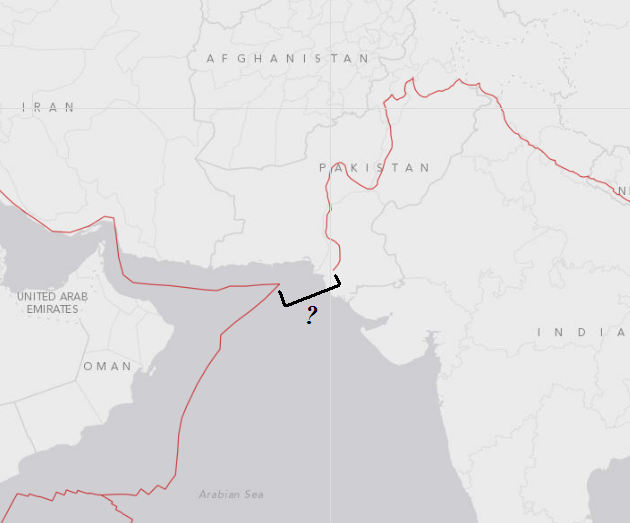
So, as I'd raised the point at that time I kept a fairly close watch on the region over the next few days. Then, four days after the above-linked post, on Dec 19, there was a magnitude 5.6 quake in Pakistan:
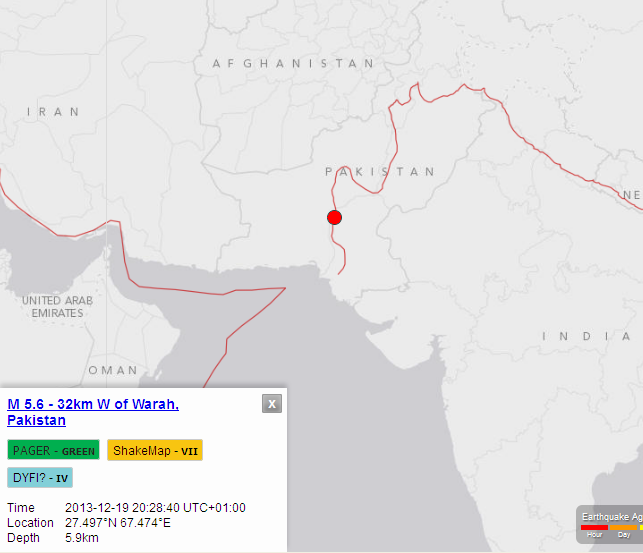
Overlaying the two images we get a better idea of the relative proximity:
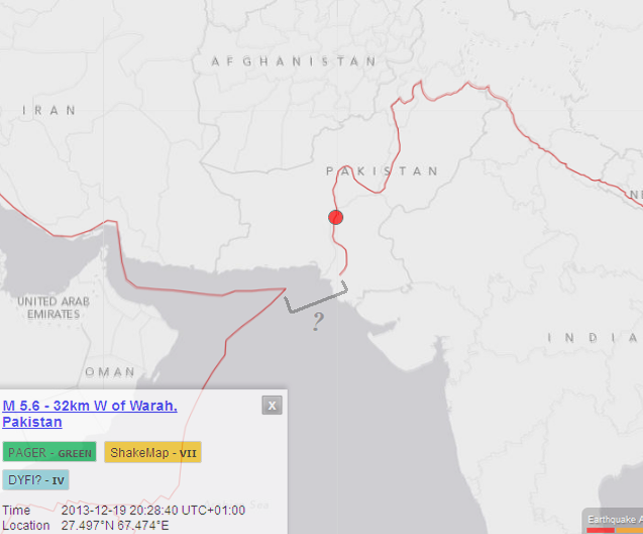
Okay, a mag 5.6 is nothing huge, especially by regional standards there, but it's not insignificant either. This quake made me a bit nervous because while it's technically on another fault line to the subduction zone, it's not too distant from that “mystery” region I marked in the first map. It's about 400 km away. While that might seem pretty far, the fault that quake was on runs down south and ends right above the “mystery” region I was puzzling over. And that fault seemingly connects to nothing.
I doubt it really connects to nothing. The big question is, what kind of fault exists in that marked region? Is that a subduction zone, or something else? Could a major movement in the mystery region have triggering effects elsewhere, such as up and down that N/S fault line – which BTW runs smack between Karachi and Hyderabad just about where it “ends”?
There was another event the next day, but it was only a mag 4.5 and even further north and I'm much less concerned about it:
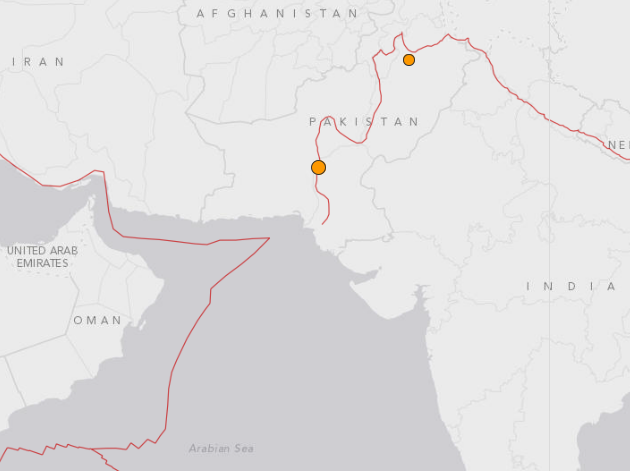 (It's the smaller orange dot in the image.)
(It's the smaller orange dot in the image.)
Fortunately, things have gone quiet again since then. There's been nothing of any note in the whole region since the 5.6 and 4.5 events.
But that fault line running down between Karachi and Hyderabad, that seems to end where the “mystery” region begins: it has me concerned, mainly because if the experts aren't willing to say what kind of fault might be there, it suggests it's been a long time since any major events occurred there to give them some guidance.
This is part of what we need to look out for: not just the places where quakes have occurred in more recent times, but regions where it looks like they should, but apparently they haven't.
A final note: the plot thickens, folks. I just did a database search on USGS and what I found is puzzling, to say the least. But I'll put that in a new post later this evening – after I've had my Christmas dinner!
Now, getting back to quake events, you may recall that in THIS POST back on Dec 15, I referred to the plate boundary just off the Pakistan coast and in particular its possible effects on both the Pakistani and Indian coastal regions. Here is the map I posted to illustrate what I was talking about:

So, as I'd raised the point at that time I kept a fairly close watch on the region over the next few days. Then, four days after the above-linked post, on Dec 19, there was a magnitude 5.6 quake in Pakistan:

Overlaying the two images we get a better idea of the relative proximity:

Okay, a mag 5.6 is nothing huge, especially by regional standards there, but it's not insignificant either. This quake made me a bit nervous because while it's technically on another fault line to the subduction zone, it's not too distant from that “mystery” region I marked in the first map. It's about 400 km away. While that might seem pretty far, the fault that quake was on runs down south and ends right above the “mystery” region I was puzzling over. And that fault seemingly connects to nothing.
I doubt it really connects to nothing. The big question is, what kind of fault exists in that marked region? Is that a subduction zone, or something else? Could a major movement in the mystery region have triggering effects elsewhere, such as up and down that N/S fault line – which BTW runs smack between Karachi and Hyderabad just about where it “ends”?
There was another event the next day, but it was only a mag 4.5 and even further north and I'm much less concerned about it:

Fortunately, things have gone quiet again since then. There's been nothing of any note in the whole region since the 5.6 and 4.5 events.
But that fault line running down between Karachi and Hyderabad, that seems to end where the “mystery” region begins: it has me concerned, mainly because if the experts aren't willing to say what kind of fault might be there, it suggests it's been a long time since any major events occurred there to give them some guidance.
This is part of what we need to look out for: not just the places where quakes have occurred in more recent times, but regions where it looks like they should, but apparently they haven't.
A final note: the plot thickens, folks. I just did a database search on USGS and what I found is puzzling, to say the least. But I'll put that in a new post later this evening – after I've had my Christmas dinner!
edit on 25/12/13 by JustMike because: (no reason given)
Okay, so in an effort to find out more about that unmarked (“mystery”) region on the USGS main world quake map, I did a search of the
USGS quake database, from Dec 24 1983 to today. (I figured if there was much going on on,
then 30 years or so should turn it up.)
The quake search was within a circle radius 160 km (approx 100 miles) centred on a point at 24.5 N, 66.4 E, that being around half-way along that empty-looking mystery region.
First I searched for quakes of mag 6.0 and above in the defined area and time frame. Nothing. So I lowered it to mag 5.0 or bigger, and got five results, which I've shown in the screenshot below:
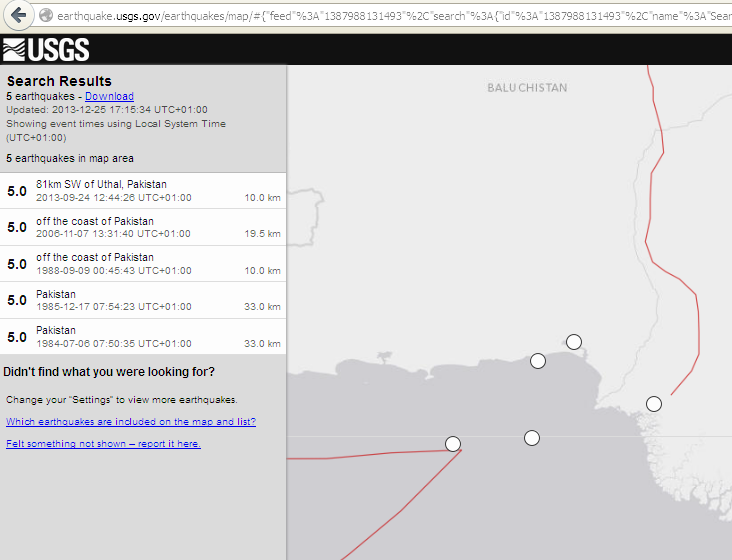
In the next image, I've marked the quakes by number. For the purpose of this exercise I'm not so interested in numbers 1 and 5, though they are not insignificant. It's 2, 3 & 4 that concern me most, because as shown on the current USGS world quake map, they follow the imaginary line between the apparent end of the defined subduction zone and somewhere near when the N/S fault runs up between Karachi and Hyderabad:
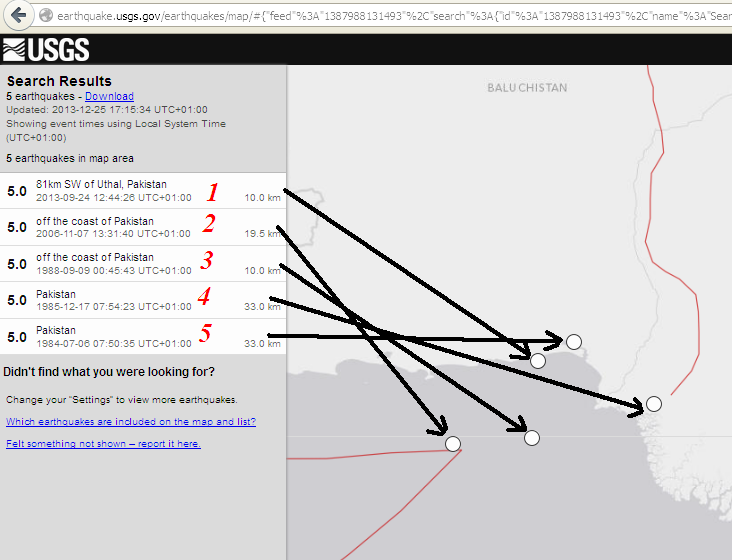
To me, those three quakes suggest something is there, along that imaginary line or very close to it.
So, taking the quake nearest the middle of that line (“number 3”), I obtained further info about it at THIS LINK via USGS:
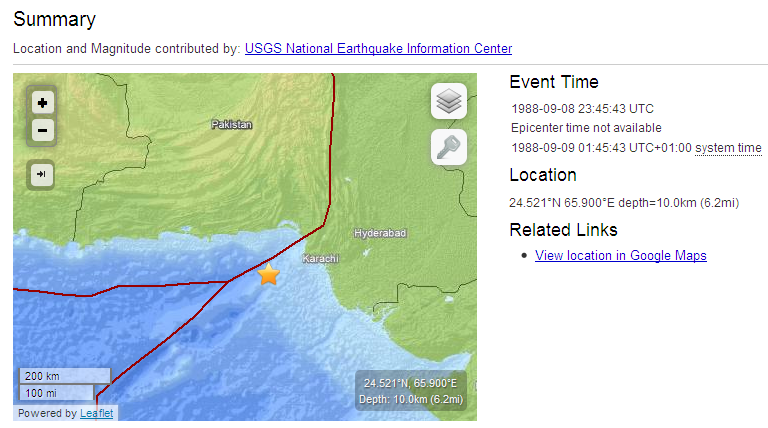
And waddaya know, there's a fault line marked there in the main USGS world quake map's “mystery” region!
Why that line is not marked on the current USGS world map I have no idea. And it doesn't even show on the main search result list/map page that I posted above! You have to go to individual, archived quakes to find it. But at least we now know that they do have some idea of where a fault line runs there.
But there's something else odd about this, because if you compare the N/S fault line in the map above with the one on the world map, its location is rather different. They just don't line up.
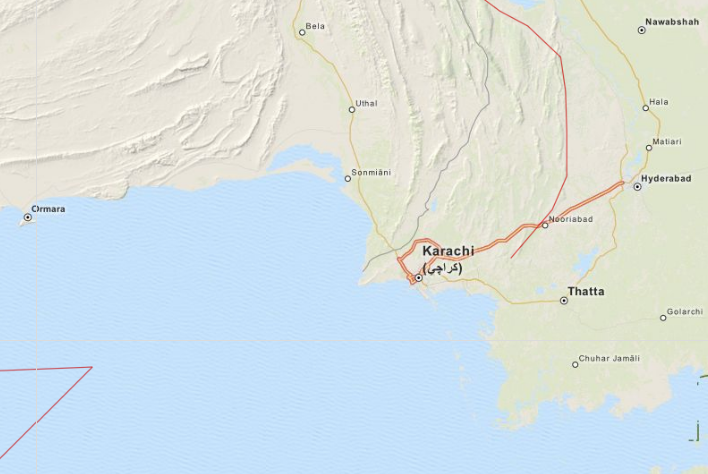 (Ignore the double E-W red line between Karachi and Hyderabad. That's a highway. The N/S one is the fault line.)
(Ignore the double E-W red line between Karachi and Hyderabad. That's a highway. The N/S one is the fault line.)
The search database reference map has the N/S fault taking a kink and heading off to the coast SW well before Karachi and Hyderabad and joining up with the subduction zone. And here's another wrinkle: at the coast, this line passes close to where quakes numbered 1 and 5 occurred. But the current world quake map (above) shows that this fault line ends pretty well on an imaginary line right between those two cities, doesn't reach the coast, and connects with nothing.
That's some pretty significant differences.
These kinds of inconsistencies in mapping what could be very significant faults are very frustrating – even to amateur researchers like yours truly – and especially when we consider that both maps are from the same organization!
Summary (aka TLDR): yes, there is an apparent fault line in what I've called the mystery region, but USGS exhibits disparities in its own maps as to exactly where it is, and where the N/S fault runs as well.
Hopefully these issues will be resolved.
The quake search was within a circle radius 160 km (approx 100 miles) centred on a point at 24.5 N, 66.4 E, that being around half-way along that empty-looking mystery region.
First I searched for quakes of mag 6.0 and above in the defined area and time frame. Nothing. So I lowered it to mag 5.0 or bigger, and got five results, which I've shown in the screenshot below:

In the next image, I've marked the quakes by number. For the purpose of this exercise I'm not so interested in numbers 1 and 5, though they are not insignificant. It's 2, 3 & 4 that concern me most, because as shown on the current USGS world quake map, they follow the imaginary line between the apparent end of the defined subduction zone and somewhere near when the N/S fault runs up between Karachi and Hyderabad:

To me, those three quakes suggest something is there, along that imaginary line or very close to it.
So, taking the quake nearest the middle of that line (“number 3”), I obtained further info about it at THIS LINK via USGS:

And waddaya know, there's a fault line marked there in the main USGS world quake map's “mystery” region!
Why that line is not marked on the current USGS world map I have no idea. And it doesn't even show on the main search result list/map page that I posted above! You have to go to individual, archived quakes to find it. But at least we now know that they do have some idea of where a fault line runs there.
But there's something else odd about this, because if you compare the N/S fault line in the map above with the one on the world map, its location is rather different. They just don't line up.

The search database reference map has the N/S fault taking a kink and heading off to the coast SW well before Karachi and Hyderabad and joining up with the subduction zone. And here's another wrinkle: at the coast, this line passes close to where quakes numbered 1 and 5 occurred. But the current world quake map (above) shows that this fault line ends pretty well on an imaginary line right between those two cities, doesn't reach the coast, and connects with nothing.
That's some pretty significant differences.
These kinds of inconsistencies in mapping what could be very significant faults are very frustrating – even to amateur researchers like yours truly – and especially when we consider that both maps are from the same organization!
Summary (aka TLDR): yes, there is an apparent fault line in what I've called the mystery region, but USGS exhibits disparities in its own maps as to exactly where it is, and where the N/S fault runs as well.
Hopefully these issues will be resolved.
edit on 25/12/13 by JustMike because: (no reason given)
Very interesting posts Mike...Odd that the line isn't included in current maps. I know you've been watching the region for awhile.
I am really hoping for a quiet couple of days, but am feeling a bit antsy. Given we haven't had any significant quakes for some time now isn't helping. Feels like something is brewing.
I am really hoping for a quiet couple of days, but am feeling a bit antsy. Given we haven't had any significant quakes for some time now isn't helping. Feels like something is brewing.
reply to post by westcoast
Just dropping in the wish everyone a Happy Christmas...hope the next year is a good one for us all. Hope you've all had a lovely lazy happy day.
Now I'm gonna ruin it all by saying I'm beyond antsy. Sorry guys. I'm just about climbing the walls with anxiety, again no known source, no stress, having a day off feels a bit weird, but it's not that. I'm really panicky, and it's not nice. Had a nap this afternoon filled with a nightmare of people lying dead in the snow, in the middle of the road...no idea what the hell that meant. Hopefully it's just me being a bit strange, although my dog is acting up now too, just in the last hour. A little slow to eat, and he's doing that prowling round the house thing that he knows makes me crazy...just wandering in and out of all the rooms, into corners, back and forth.
Stay safe everyone, and stay in touch.
Cait xxx
Just dropping in the wish everyone a Happy Christmas...hope the next year is a good one for us all. Hope you've all had a lovely lazy happy day.
Now I'm gonna ruin it all by saying I'm beyond antsy. Sorry guys. I'm just about climbing the walls with anxiety, again no known source, no stress, having a day off feels a bit weird, but it's not that. I'm really panicky, and it's not nice. Had a nap this afternoon filled with a nightmare of people lying dead in the snow, in the middle of the road...no idea what the hell that meant. Hopefully it's just me being a bit strange, although my dog is acting up now too, just in the last hour. A little slow to eat, and he's doing that prowling round the house thing that he knows makes me crazy...just wandering in and out of all the rooms, into corners, back and forth.
Stay safe everyone, and stay in touch.
Cait xxx
Hello again.... Just logging in. Another nightmare to report last night, of big seas, lots of rushing water, massive blocks of ice floating off,
very stormy threatening atmosphere, and the dog and I were in the middle of it all, with that "We're not in Kansas anymore, Toto" feeling. It was
nasty, like a chunk of land had slipped into the sea somewhere, and it felt like Alaska, Greenland, Iceland, Patagonia, somewhere a bit wild. But not
Scotland, I hope.
I'm still re-reading Mike's awesome posts earlier, by the way...so much information!
I'm still re-reading Mike's awesome posts earlier, by the way...so much information!
Very sudden pounding headache, nausea, and loud ear ringing.
Ear ringing hasn't stopped for a half hour.
Gonna go lay down, but just wanted to post this. Solar maybe?
Peace and hugs
Ear ringing hasn't stopped for a half hour.
Gonna go lay down, but just wanted to post this. Solar maybe?
Peace and hugs
Yep, after the handful of high five quakes,
hubby & I both had to go lay down.
Really had the sleeping pill effect!
Thought it was going without enough sleep for the last few days.
Poor young cat was doing her darnedest to try & wake me up too.
Couldn't wake up for hours! Not like me at all!
Really loud ringing in my right ear when I woke up.
Hubby had the pain in his chest again too.
We fell sleep at different times, in different rooms,
but both woke up at exactly the same time! Weird!
Was sure I would see at least a 6+ when I looked!
WOQ
Just came back to ad...
Even though we slept for hours, it just started hitting us again!
Over the top tiredness!!!
WTHeck is going on???
hubby & I both had to go lay down.
Really had the sleeping pill effect!
Thought it was going without enough sleep for the last few days.
Poor young cat was doing her darnedest to try & wake me up too.
Couldn't wake up for hours! Not like me at all!
Really loud ringing in my right ear when I woke up.
Hubby had the pain in his chest again too.
We fell sleep at different times, in different rooms,
but both woke up at exactly the same time! Weird!
Was sure I would see at least a 6+ when I looked!
WOQ
Just came back to ad...
Even though we slept for hours, it just started hitting us again!
Over the top tiredness!!!
WTHeck is going on???
edit on 28-12-2013 by wasobservingquietly because: (no reason given)
Hello0o ..
Merry Christmas to all and Happy New Year!
I think we will have stronger activity also strong EQ in next 5 or max 7 days, guess probably around or stronger of M 7.6 + ..
Hope not ..
Merry Christmas to all and Happy New Year!
I think we will have stronger activity also strong EQ in next 5 or max 7 days, guess probably around or stronger of M 7.6 + ..
Hope not ..
reply to post by MariaLida
Merry Christmas and Happy New Year to you all. xoxox
While you are guessing... make a guess as to where. Eq's are really picking up as of late. I guess the quiet was pressure building? IDK.
Italy just had a good one and here in the states OK had a good one although there are currently no I felt it reports on Earthquake-report.com
Merry Christmas and Happy New Year to you all. xoxox
While you are guessing... make a guess as to where. Eq's are really picking up as of late. I guess the quiet was pressure building? IDK.
Italy just had a good one and here in the states OK had a good one although there are currently no I felt it reports on Earthquake-report.com
Morning all...
What say you all to the Canary Islands just now? El Hierro is a bit jumpy, and it makes me wonder about the dream I had a few nights back. There is some solar stuff going on too, and I'm wondering what effect it might have on seismic activity. Maybe something to watch. I'm still not sleeping properly, but might just be the new house and still having far to much to do.
What say you all to the Canary Islands just now? El Hierro is a bit jumpy, and it makes me wonder about the dream I had a few nights back. There is some solar stuff going on too, and I'm wondering what effect it might have on seismic activity. Maybe something to watch. I'm still not sleeping properly, but might just be the new house and still having far to much to do.
Hi everyone,
sorry to hear that many of you have been feeling jumpy/antsy. I have to report that at about 1 am today my time (midnight UTC Dec 29 to 30th) I experienced some very loud ear ringing for a few minutes. I was up late, just doing some writing, when it suddenly started. I have some tinnitus but it's well within normal ranges for my age, but what I felt this morning was way beyond the "usual" for me. Very distracting and quite unpleasant. After a few minutes it faded away.
Anyway I thought it best to log it here.
On the world-wide quake front, we are still having a pretty quiet time in respect of mag 6 or bigger events right now. Since Dec 1, there have been only three: a 6.4 and a 6.0 in different parts of Indonesia on Dec 1 itself and a 6.2 in the Nthn Mariana Islands on Dec 18. Up til this month, there had been 138 mag 6 or greater events from 1/1/2013 to Nov 30, working out at around one every 2.4 days.
So, while we've had more quakes than in 2012, when there were 133 mag 6 or bigger events (a pretty quiet year) it's finishing with a rather quiet month.
I did a check of the USGS database for mag 7 or bigger events. We've already had 19 this year, including two in the mag 8 range. (Feb 6 and May 24.) Three of the mag 7 events seem to be aftershocks of the Feb 6 mag 8.0 in the Solomon Islands, but even allowing for those we're pretty well on the average. (About 15 or 16 per year, based on the 100 years of data in the Centennial Earthquake Catalog.)
However, while long-term data are useful, frankly I have to agree with Maria. I expect there could be a fairly decent-sized one pretty soon. I've mentioned my concerns already about that Pakistani region but that's just an observation based upon studying the are and okay, my gut feeling that it's not very stable there and it seems not too much is known about that “mystery” section of fault line.
As you all know, I'd rather these bigger quakes happened where there are no people. I honestly wouldn't wish a big quake on my worst enemy and I'm sure you feel the same.
But seeing as it doesn't work that way, all we can do is hope for the best.
sorry to hear that many of you have been feeling jumpy/antsy. I have to report that at about 1 am today my time (midnight UTC Dec 29 to 30th) I experienced some very loud ear ringing for a few minutes. I was up late, just doing some writing, when it suddenly started. I have some tinnitus but it's well within normal ranges for my age, but what I felt this morning was way beyond the "usual" for me. Very distracting and quite unpleasant. After a few minutes it faded away.
Anyway I thought it best to log it here.
On the world-wide quake front, we are still having a pretty quiet time in respect of mag 6 or bigger events right now. Since Dec 1, there have been only three: a 6.4 and a 6.0 in different parts of Indonesia on Dec 1 itself and a 6.2 in the Nthn Mariana Islands on Dec 18. Up til this month, there had been 138 mag 6 or greater events from 1/1/2013 to Nov 30, working out at around one every 2.4 days.
So, while we've had more quakes than in 2012, when there were 133 mag 6 or bigger events (a pretty quiet year) it's finishing with a rather quiet month.
I did a check of the USGS database for mag 7 or bigger events. We've already had 19 this year, including two in the mag 8 range. (Feb 6 and May 24.) Three of the mag 7 events seem to be aftershocks of the Feb 6 mag 8.0 in the Solomon Islands, but even allowing for those we're pretty well on the average. (About 15 or 16 per year, based on the 100 years of data in the Centennial Earthquake Catalog.)
However, while long-term data are useful, frankly I have to agree with Maria. I expect there could be a fairly decent-sized one pretty soon. I've mentioned my concerns already about that Pakistani region but that's just an observation based upon studying the are and okay, my gut feeling that it's not very stable there and it seems not too much is known about that “mystery” section of fault line.
As you all know, I'd rather these bigger quakes happened where there are no people. I honestly wouldn't wish a big quake on my worst enemy and I'm sure you feel the same.
But seeing as it doesn't work that way, all we can do is hope for the best.
new topics
-
Paradox of Progress
Ancient & Lost Civilizations: 12 minutes ago -
Joe Biden gives the USA's Highest Civilian Honor Award to Hillary Clinton and George Soros.
US Political Madness: 2 hours ago -
Winter Storm
Fragile Earth: 3 hours ago -
Biden Face Planted Somewhere
Politicians & People: 5 hours ago -
A great artist and storyteller, for kids of all ages
General Entertainment: 5 hours ago -
What Is 'Quad Demic'? Mask Mandate Returns In These US States
Diseases and Pandemics: 9 hours ago -
The Future of fashion .
Social Issues and Civil Unrest: 10 hours ago -
Bin Cyber Junk…
Short Stories: 10 hours ago -
The Undertones - Teenage Kicks
Music: 11 hours ago -
Volcano Watch 2025
Fragile Earth: 11 hours ago
top topics
-
Joe Biden gives the USA's Highest Civilian Honor Award to Hillary Clinton and George Soros.
US Political Madness: 2 hours ago, 10 flags -
What Is 'Quad Demic'? Mask Mandate Returns In These US States
Diseases and Pandemics: 9 hours ago, 10 flags -
The Future of fashion .
Social Issues and Civil Unrest: 10 hours ago, 8 flags -
Volcano Watch 2025
Fragile Earth: 11 hours ago, 7 flags -
Winter Storm
Fragile Earth: 3 hours ago, 7 flags -
Bin Cyber Junk…
Short Stories: 10 hours ago, 6 flags -
Biden Face Planted Somewhere
Politicians & People: 5 hours ago, 5 flags -
A great artist and storyteller, for kids of all ages
General Entertainment: 5 hours ago, 4 flags -
The Undertones - Teenage Kicks
Music: 11 hours ago, 3 flags -
Paradox of Progress
Ancient & Lost Civilizations: 12 minutes ago, 1 flags
active topics
-
-@TH3WH17ERABB17- -Q- ---TIME TO SHOW THE WORLD--- -Part- --44--
Dissecting Disinformation • 3930 • : duncanagain -
Joe Biden gives the USA's Highest Civilian Honor Award to Hillary Clinton and George Soros.
US Political Madness • 20 • : BingoMcGoof -
Paradox of Progress
Ancient & Lost Civilizations • 0 • : ChaoticOrder -
Winter Storm
Fragile Earth • 14 • : NorthOS -
NJ Drones tied to Tesla explosion at Trump Las vegas
General Conspiracies • 44 • : KrustyKrab -
Judge rules president-elect Donald Trump must be sentenced in 'hush money' trial
US Political Madness • 18 • : marg6043 -
Volcano Watch 2025
Fragile Earth • 6 • : rickymouse -
The Future of fashion .
Social Issues and Civil Unrest • 18 • : KrustyKrab -
Tesla Cybertruck Explodes in Front of Trump Hotel in Las Vegas
Mainstream News • 221 • : fringeofthefringe -
Strange fog all over the northern hemisphere
General Conspiracies • 49 • : Irishhaf
